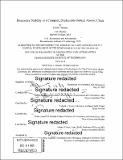| dc.contributor.author | Sheerin, Todd F.
(Todd Fillmore) | en_US |
| dc.contributor.other | Massachusetts Institute of Technology. Department of Aeronautics and Astronautics. | en_US |
| dc.date.accessioned | 2022-01-25T16:14:24Z | |
| dc.date.available | 2022-01-25T16:14:24Z | |
| dc.date.copyright | 2019 | en_US |
| dc.date.issued | 2019 | en_US |
| dc.identifier.uri | https://hdl.handle.net/1721.1/139714 | |
| dc.description | Thesis: Ph. D., Massachusetts Institute of Technology, Department of Aeronautics and Astronautics, June, 2019 | en_US |
| dc.description | Cataloged from the official PDF of thesis. | en_US |
| dc.description | Includes bibliographical references (pages 293-298). | en_US |
| dc.description.abstract | The advent of ultra-narrow lasers, ultra-fast lasers, and optical frequency combs in the last several decades have enabled a new generation of atomic clocks based on optical transitions as opposed to microwave transitions While optical atomic clocks in the laboratory outperform microwave standards by orders of magnitude, their complexity, size, weight, and power have so far precluded their application to fielded, compact systems Efforts described in this thesis to transfer optical atomic timekeeping technology from the laboratory to the field and to improve analytic tools for spectroscopy with ultra-narrow lasers are motivated by a need to support GPS-denied operations (a DARPA objective) and to enable a broad range of positioning, navigation, and timing applications in civil, commercial, and defense sectors Existing theoretical frameworks describing coupling strength for atom-laser interactions in optical atomic systems implicitly assume broad laser linewidths This thesis explores possible spectroscopic implications of ultra-narrow lasers interacting with atoms Additionally, a simple optical atomic clock architecture based on thermal calcium Ramsey-Bordé (R-B) matter-wave interferometry is described Experimental investigations in this thesis were carried out in two systems a compact, deployable Ca Beam Optical Timekeeping (CaBOT) clock, and a second-generation laboratory clock at NIST (Ca-2) This thesis describes a performance evaluation of the CaBOT frequency reference exhibiting fractional frequency instability of 5 0x10⁻¹⁴ at one second Measurement noise floor analyses revealed excess laser noise to be the dominant performance limitation With modest improvements, instability is projected to reach the 10⁻¹⁵ decade In the Ca-2 system, temperature fluctuations were observed to drive instability for time scales >100s, and a temperature-frequency correlation study indicated that temperature control at the mK level would enable 10⁻¹⁶ instability A thermal enclosure limiting frequency reference temperature variations to 10s-mK enabled repeatable, sustained Ca-2 operations with </=2x10⁻¹⁶ instability between 10s-1,000s Finally, a thermal-fluid temperature control system was designed for the deployable CaBOT clock to dissipate ~220W and maintain mK level instability for the <0 09 m³ chassis with low added noise Physical demonstration of sub-mK temperature control with a model liquid cooling circuit indicated the potential for excellent mid- to long-term stability of the CaBOT clock when fully integrated | en_US |
| dc.description.statementofresponsibility | by Todd F. Sheerin. | en_US |
| dc.format.extent | 298 pages | en_US |
| dc.language.iso | eng | en_US |
| dc.publisher | Massachusetts Institute of Technology | en_US |
| dc.rights | MIT theses may be protected by copyright. Please reuse MIT thesis content according to the MIT Libraries Permissions Policy, which is available through the URL provided. | en_US |
| dc.rights.uri | http://dspace.mit.edu/handle/1721.1/7582 | en_US |
| dc.subject | Aeronautics and Astronautics. | en_US |
| dc.title | Frequency stability in a compact, deployable optical atomic clock | en_US |
| dc.type | Thesis | en_US |
| dc.description.degree | Ph. D. | en_US |
| dc.contributor.department | Massachusetts Institute of Technology. Department of Aeronautics and Astronautics | en_US |
| dc.identifier.oclc | 1292981433 | en_US |
| dc.description.collection | Ph. D. Massachusetts Institute of Technology, Department of Aeronautics and Astronautics | en_US |
| dspace.imported | 2022-01-25T16:14:24Z | en_US |
| mit.thesis.degree | Doctoral | en_US |
| mit.thesis.department | Aero | en_US |
